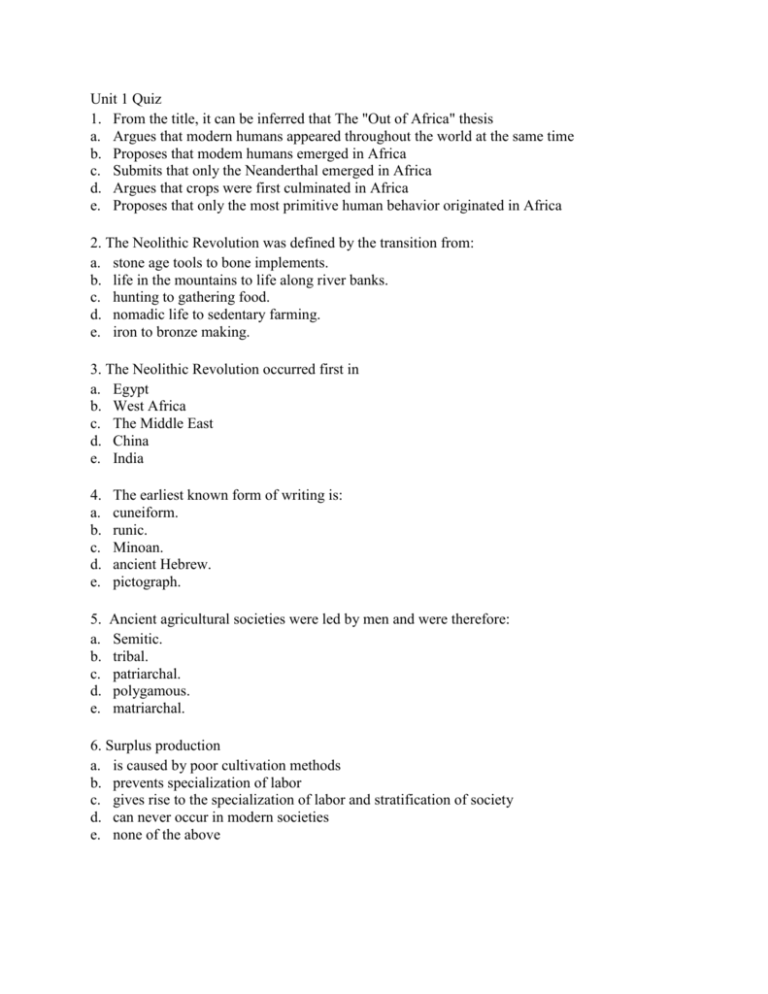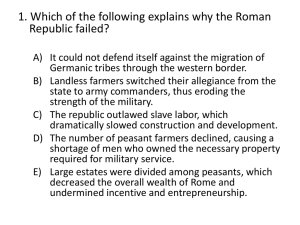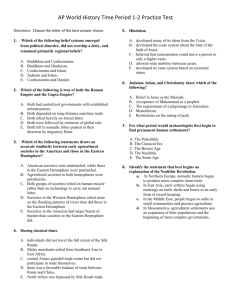File
advertisement

Unit 1 Quiz 1. From the title, it can be inferred that The "Out of Africa" thesis a. Argues that modern humans appeared throughout the world at the same time b. Proposes that modem humans emerged in Africa c. Submits that only the Neanderthal emerged in Africa d. Argues that crops were first culminated in Africa e. Proposes that only the most primitive human behavior originated in Africa 2. The Neolithic Revolution was defined by the transition from: a. stone age tools to bone implements. b. life in the mountains to life along river banks. c. hunting to gathering food. d. nomadic life to sedentary farming. e. iron to bronze making. 3. The Neolithic Revolution occurred first in a. Egypt b. West Africa c. The Middle East d. China e. India 4. a. b. c. d. e. The earliest known form of writing is: cuneiform. runic. Minoan. ancient Hebrew. pictograph. 5. a. b. c. d. e. Ancient agricultural societies were led by men and were therefore: Semitic. tribal. patriarchal. polygamous. matriarchal. 6. Surplus production a. is caused by poor cultivation methods b. prevents specialization of labor c. gives rise to the specialization of labor and stratification of society d. can never occur in modern societies e. none of the above 7. Which of the following is an incorrect description of agricultural societies? a. Agriculture allowed humans to manipulate their environment as never before. b. Women probably played a key role in promoting the transition from hunting and gathering to agricultural societies. c. Agriculture promoted permanent settlements d. People began producing their own food nearly 12,000 years ago e. Agricultural societies were less organized than hunter-gatherer societies. 8. a. b. c. d. e. One of the main innovative ideas in Hammurabi’s law code was that the ruler’s will is to be followed at all costs the upper class are to have the most rights the lower classes were to have special privileges a consistent set of regulations should govern society anyone who spoke against the king would be executed 9. Hunting and gathering societies were marked by I - widespread specialization of labor II - a subsistence lifestyle III - limited trade IV - little specialization of labor a. b. c. d. e. I and III II and IV I, II, and III II, III, and IV IV only 10. In Greek society, women were treated as a. Equals to men, especially when it came to voting b. Gods c. Inferior to men in both social and political affairs d. Slaves in every household e. None of the above 11. Which of the following is an accurate description of the Indian Caste system? a. Its top stratum was the untouchables b. Its top stratum was the Sikhs. c. People enjoyed social mobility. d. All Hindu’s were in the untouchable class. e. There was virtually no social mobility. 12. In comparing the Han Dynasty with the Roman Empire, which of the following statements is NOT correct? a. both the Han Dynasty’s and the Roman Empire’s economies suffered as a result of military spending. b. while Rome was successful at spreading its culture across a wide area, the Han were unable to diffuse their culture to neighboring lands. c. while both societies were run by centralized governments, Rome gave significant autonomy to local officials. d. while the Chinese were able to re-establish their imperial empire, Rome was never restored to its former status e. a byproduct of military expansion in both societies was cultural diffusion and increased trade. 13. The foundation of Indian civilization is best described by all of the following EXCEPT a. reincarnation b. the Dao c. caste d. karma e. Hinduism 14. After the Peloponnesian War, the Macedonians took control of Greece and spread Greek culture throughout much of the known world under the leadership of a. Alexander the Great b. Julius Caesar c. Hannibal d. Pericles e. Socrates 15. In which of these societies were merchants and traders placed in a lower social class than farmers and artisans? a. Byzantium b. Han China c. India d. Japan e. Rome 16. Which of the following is a key philosophical and religious element of Daoism? a. Respect for one’s ancestors as critical to proper behavior. b. Unquestioning obedience to the ruler c. Belief in the Mandate of Heaven d. Emphasis on harmony between humans and nature e. Precedence of one’s duty to family over other obligations 17. Which of the following was one important reason for the fall of the Roman Empire in the West? a. A long period of drought that destroyed lifestock and crops. b. A syphilis epidemic that spread throughout the Roman Empire c. The use of slaves in the Roman Empire d. Widespread and intensified invasions by Barbarians. e. The refusal to tolerate Islam. 18. Buddhism differed from Hinduism by not believing a. In the caste system b. in holy leaders c. in nirvana d. in the importance of moral obligations e. in spreading the faith 19. By 600 C.E, looking at the entire world, a good definition of “barbarian” would be a. Someone who fights better than a peasant-soldier b. Someone who is not Christian c. Someone who is not part of a civilization d. Someone who is illiterate e. Someone who is a knight 20. Which of the following is NOT an accurate statement about Confucianism? a. The ethical system us primarily concerned with relationships. b. Specific duties are tied to one’s status in society. c. It prescribes the correct organization of the state to achieve the maximum benefits for the most members of society. d. People are basically good and evil arises as a result of improper education. e. Only those who are devout and lead moral lives will be saved. 21. Which technologies are generally thought to have been acquired by Paleolithic societies? I. fire II. stone tools III. iron IV. bronze a. I b. I and II c. I, II and III d. I, II, and IV e. none of the above 22. The emergence of agriculture, or the Neolithic Revolution, caused all of the following EXCEPT a. the ability of humans to settle more permanently in one spot. b. a population explosion. c. an increase in the specialization of political, economic, and religious functions. d. the introduction of artistic expression. e. the disappearance of hunter-gatherer communities. 23. Women were important contributors to the Agricultural Revolution because they were likely the ones who a. traded grains for meat b. made tools and containers c. gathered edible plants and knew where grains grew d. performed essential agricultural tasks such as plowing and irrigation e. found that farming required less work and less time 24. The statue above was produced in: a. ancient Persia. b. medieval Europe. c. Mughal India. d. ancient Greece. e. prehistoric France. 25. How did the collapse of Han China most resemble the Roman Empire's loss of its European lands? a. Both were later devoured by the Byzantine Empire. b. Their leaders began to rely on Buddhism to guide their decision making. c. Both fell as a result of depletion of natural resources. d. Outside invaders contributed to the collapse of both empires. e. Both collapsed due to lack of technological innovation. 26. The map above shows a. Indian Ocean Trading System b. The Silk Road c. The Han Empire system of roads d. The Amber road e. Trans-Saharan trade routes 27. A major difference between the teachings of Buddhism and Hinduism is a. belief in nirvana. b. the cycle of rebirth. c. the principle of nonviolence. d. belief in karma. e. belief in castes. 28. Confucianism is characterized by all of the following beliefs except: a. nobility is acquired through virtue, not birth b. people should treat others as they themselves would be treated c. everyone should carry out his social duties with devotion d. government must have the confidence of the people e. devotion to one’s family is not as important as devotion to oneself Teacher Copy Unit 1 Quiz 1. From the title, it can be inferred that The "Out of Africa" thesis a. b. c. d. e. Argues that modern humans appeared throughout the world at the same time Proposes that modem humans emerged in Africa Submits that only the Neanderthal emerged in Africa Argues that crops were first culminated in Africa Proposes that only the most primitive human behavior originated in Africa 2. The Neolithic Revolution was defined by the transition from: a. b. c. d. e. stone age tools to bone implements. life in the mountains to life along river banks. hunting to gathering food. nomadic life to sedentary farming. iron to bronze making. 3. The Neolithic Revolution occurred first in a. b. c. d. e. Egypt West Africa The Middle East China India 5. The earliest known form of writing is: a. b. c. d. e. cuneiform. runic. Minoan. ancient Hebrew. pictograph. 6. Ancient agricultural societies were led by men and were therefore: b. c. d. e. a. Semitic. tribal. patriarchal. polygamous. matriarchal. 7. Surplus production a. b. c. d. e. is caused by poor cultivation methods prevents specialization of labor gives rise to the specialization of labor and stratification of society can never occur in modern societies none of the above 8. Which of the following is an incorrect description of agricultural societies? a. Agriculture allowed humans to manipulate their environment as never before. b. Women probably played a key role in promoting the transition from hunting and gathering to agricultural societies. c. Agriculture promoted permanent settlements d. People began producing their own food nearly 12,000 years ago e. Agricultural societies were less organized than hunter-gatherer societies. 9. One of the main innovative ideas in Hammurabi’s law code was that a. b. c. d. e. the ruler’s will is to be followed at all costs the upper class are to have the most rights the lower classes were to have special privileges a consistent set of regulations should govern society anyone who spoke against the king would be executed 9. Hunting and gathering societies were marked by I - widespread specialization of labor II - a subsistence lifestyle III - limited trade IV - little specialization of labor a. b. c. d. e. I and III II and IV I, II, and III II, III, and IV IV only 10. a. b. c. d. e. In Greek society, women were treated as Equals to men, especially when it came to voting Gods Inferior to men in both social and political affairs Slaves in every household None of the above 11. Which of the following is an accurate description of the Indian Caste system? a. b. c. d. e. Its top stratum was the untouchables Its top stratum was the Sikhs. People enjoyed social mobility. All Hindu’s were in the untouchable class. There was virtually no social mobility. 12. In comparing the Han Dynasty with the Roman Empire, which of the following statements is NOT correct? a. both the Han Dynasty’s and the Roman Empire’s economies suffered as a result of military spending. b. while Rome was successful at spreading its culture across a wide area, the Han were unable to diffuse their culture to neighboring lands. c. while both societies were run by centralized governments, Rome gave significant autonomy to local officials. d. while the Chinese were able to re-establish their imperial empire, Rome was never restored to its former status e. a byproduct of military expansion in both societies was cultural diffusion and increased trade. 13. The foundation of Indian civilization is best described by all of the following EXCEPT a. b. c. d. e. reincarnation the Dao caste karma Hinduism 14. After the Peloponnesian War, the Macedonians took control of Greece and spread Greek culture throughout much of the known world under the leadership of a. b. c. d. e. Alexander the Great Julius Caesar Hannibal Pericles Socrates 15. In which of these societies were merchants and traders placed in a lower social class than farmers and artisans? a. b. c. d. e. Byzantium Han China India Japan Rome 16. Which of the following is a key philosophical and religious element of Daoism? a. b. c. d. e. Respect for one’s ancestors as critical to proper behavior. Unquestioning obedience to the ruler Belief in the Mandate of Heaven Emphasis on harmony between humans and nature Precedence of one’s duty to family over other obligations 17. Which of the following was one important reason for the fall of the Roman Empire in the West? a. b. c. d. e. A long period of drought that destroyed lifestock and crops. A syphilis epidemic that spread throughout the Roman Empire The use of slaves in the Roman Empire Widespread and intensified invasions by Barbarians. The refusal to tolerate Islam. 18. Buddhism differed from Hinduism by not believing a. In the caste system b. in holy leaders c. in nirvana d. in the importance of moral obligations e. in spreading the faith 18. By 600 C.E, looking at the entire world, a good definition of “barbarian” would be a. b. c. d. e. Someone who fights better than a peasant-soldier Someone who is not Christian Someone who is not part of a civilization Someone who is illiterate Someone who is a knight 19. Which of the following is NOT an accurate statement about Confucianism? a. The ethical system us primarily concerned with relationships. b. Specific duties are tied to one’s status in society. c. It prescribes the correct organization of the state to achieve the maximum benefits for the most members of society. d. People are basically good and evil arises as a result of improper education. e. Only those who are devout and lead moral lives will be saved. 21. Which technologies are generally thought to have been acquired by Paleolithic societies? I. fire II. stone tools III. iron IV. bronze a. I b. I and II c. I, II and III d. I, II, and IV e. none of the above 22. The emergence of agriculture, or the Neolithic Revolution, caused all of the following EXCEPT a. the ability of humans to settle more permanently in one spot. b. a population explosion. c. an increase in the specialization of political, economic, and religious functions. d. the introduction of artistic expression. e. the disappearance of hunter-gatherer communities. 23. Women were important contributors to the Agricultural Revolution because they were likely the ones who a. traded grains for meat b. made tools and containers c. gathered edible plants and knew where grains grew d. performed essential agricultural tasks such as plowing and irrigation e. found that farming required less work and less time 24. The statue above was produced in: a. ancient Persia. b. medieval Europe. c. Mughal India. d. ancient Greece. e. prehistoric France. 25. How did the collapse of Han China most resemble the Roman Empire's loss of its European lands? a. Both were later devoured by the Byzantine Empire. b. Their leaders began to rely on Buddhism to guide their decision making. c. Both fell as a result of depletion of natural resources. d. Outside invaders contributed to the collapse of both empires. e. Both collapsed due to lack of technological innovation. 26. The map above shows a. Indian Ocean Trading System b. The Silk Road c. The Han Empire system of roads d. The Amber road e. Trans-Saharan trade routes 27. A major difference between the teachings of Buddhism and Hinduism is a. belief in nirvana. b. the cycle of rebirth. c. the principle of nonviolence. d. belief in karma. e. belief in castes. 28. Confucianism is characterized by all of the following beliefs except: a. nobility is acquired through virtue, not birth b. people should treat others as they themselves would be treated c. everyone should carry out his social duties with devotion d. government must have the confidence of the people e. devotion to one’s family is not as important as devotion to oneself








